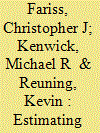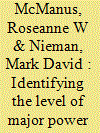| Srl | Item |
| 1 |
ID:
176048


|
|
|
|
|
| Summary/Abstract |
Counting repressive events is difficult because state leaders have an incentive to conceal actions of their subordinates and destroy evidence of abuse. In this article, we extend existing latent variable modeling techniques in the study of repression to account for the uncertainty inherent in count data generated for this type of difficult-to-observe event. We demonstrate the utility of the model by focusing on a dataset that defines ‘one-sided-killing’ as government-caused deaths of non-combatants. In addition to generating more precise estimates of latent repression levels, the model also estimates the probability that a state engaged in one-sided-killing and the predictive distribution of deaths for each country-year in the dataset. These new event-based, count estimates will be useful for researchers interested in this type of data but skeptical of the comparability of such events across countries and over time. Our modeling framework also provides a principled method for inferring unobserved count variables based on conceptually related categorical information.
|
|
|
|
|
|
|
|
|
|
|
|
|
|
|
|
| 2 |
ID:
165999


|
|
|
|
|
| Summary/Abstract |
Major powers signal support for protégés in order to reassure them and deter harm against them. Yet, it is not always clear how to identify who a major power’s protégés are or the degree of support signaled. Major powers have a variety of complementary signals to choose among, including alliances, arms transfers, joint military exercises, and others. It can be difficult to weigh the importance of individual signals, especially since different major powers do not deploy each signal in the same way. We address this challenge using a Bayesian latent measurement model, which provides a theoretically coherent means of identifying the overall level of support signaled by a major power for a protégé. Our approach yields a cross-sectional time-series dataset, providing a continuous measure of the degree of support signaled by major powers for all minor powers from 1950 to 2012. Our model also provides insights regarding which signals of support are most informative when sent by each major power. We find considerable variation among major powers regarding which of their signals are most meaningful, but in general alliances and military exercises tend to be among the most important signals. In further applications using our latent measure, we also assess under which conditions major powers are likely to increase their signals of support for protégés, as well as predict whether a major power will intervene in conflicts involving its protégés.
|
|
|
|
|
|
|
|
|
|
|
|
|
|
|
|